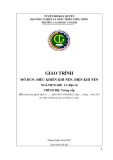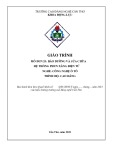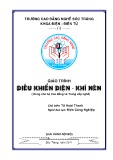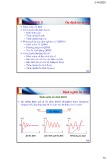Lecture Notes
Lecture Notes
Fundamentals of Control Systems
Fundamentals of Control Systems
Instructor: Assoc. Prof. Dr. Huynh Thai Hoang
Department of Automatic Control
Faculty of Electrical & Electronics Engineering
Ho Chi Minh City University of Technology
Ho Chi Minh City University of Technology
Email: hthoang@hcmut.edu.vn
huynhthaihoang@yahoo.com
Homepage: www4.hcmut.edu.vn/~hthoang/
Homepage: www4 hcmut edu vn/ hthoang/
6 December 2013 © H. T. Hoang - www4.hcmut.edu.vn/~hthoang/ 1
Chapter 9
Chapter 9
DESIGN OF
DESIGN OF
DISCRETE CONTROL SYSTEMS
DISCRETE CONTROL SYSTEMS
6 December 2013 © H. T. Hoàng - www4.hcmut.edu.vn/~hthoang/ 2
Content
Content
Introduction
Introduction
Discrete lead – lag compensator and PID controller
Design discrete systems in the Z domain
Design discrete systems in the Z domain
Controllability and observability of discrete systems
Design state feedback controller using pole
D i
db k
ll
f
t
t
i
l
t
placement
Design state estimator
Design state estimator
6 December 2013 © H. T. Hoàng - www4.hcmut.edu.vn/~hthoang/ 3
Discrete lead lag compensators
Discrete lead lag compensators
and PID controllers
and PID controllers
6 December 2013 © H. T. Hoàng - www4.hcmut.edu.vn/~hthoang/ 4
Control schemes
Control schemes
Serial compensator
Serial compensator
R(z)
Y(z)
ZOH
G(z)
GC(z)
C
+
T
T
H(z)
H( )
State feedback control
State feedback control
u(k)
r(k)
x(t)
y(k)
Cd
C
x
(
(
k
k
k
)(
)(
k
ku
)(
)(
k
)1
)1
xA
A
d
B
B
d
+
+
K
K
6 December 2013 © H. T. Hoàng - www4.hcmut.edu.vn/~hthoang/ 5
Transfer function of discrete difference term
Transfer function of discrete difference term
u(k)
u(k)
e(k)
e(k)
D
Differential term:
tu
)(
)(
tde
)(
td
dt
(
kTe
)1
T
]
)
Discrete difference:
(
kTu
)
)(
zE
)(
zU
[(
ke
T
1
)(
zEz
T
Transfer function of the discrete difference term:
1
)(
)(
zGD
G
1
z
zT
6 December 2013
© H. T. Hoàng - www4.hcmut.edu.vn/~hthoang/
6
Transfer function of discrete integral term
Transfer function of discrete integral term
e(t)
e(t)
u(t)
u(t)
Integral
I t
l
t
Continuous integral:
Continuous integral:
)(
t
tu
)(
e
)(
d
d
)(
0
kT
(
k
kT
(
kTu
)
e
)(
d
Discrete integral:
l
t
Di
t
i
)1
T
)(
e
d
0
(
0
k
)(
d
e
T
)1
kT
=
-
t
u kT
(
(
kT
)
)
u k
[(
[(
k
1)
1)
T
T
]
]
e
dt
( )
( )
d
=
-
+
-
+
u k
[(
[(
k
1)
1)
T
T
]
]
e k
[(
[(
k
1)
1)
T
T
]
]
e kT
(
(
kT
)
)
(
(
+ ò
+ ò
T
T
2
-
(
k
1)
T
U
zU
)(
)(
1
1
zUz
)(
)(
U
1
1
zEz
)(
)(
E
)(
)(
zE
E
T
T
2
TF of discrete integral term:
TF of discrete integral term:
zGI
G
)(
)(
1
1
zT
z
2
6 December 2013
© H. T. Hoàng - www4.hcmut.edu.vn/~hthoang/
7
Transfer function of discrete PID controller
Transfer function of discrete PID controller
Continuous PID controller:
C ti
PID
ll
t
G
K
)(
)(
s
PID
PID
P
P
sK
D
D
K
s
Discrete PID controller:
1
z
G
)(
z
K
PID
P
1
1
zTK
I
2
z
K
D
T
z
P
D
I
z
1
1
G
K
z
)(
or
PID
TK
I
P
z
1
K
K
D
T
z
z
I
D
P
6 December 2013
© H. T. Hoàng - www4.hcmut.edu.vn/~hthoang/
8
Digital PID controller
Digital PID controller
r(k)
(k)
e(k)
u(k)
y(k)
+
D/A
G(s)
PID
A/D
1
G
)(
)(
z
K
PID
PID
P
P
)(
zU
)(
)(
zE
zTK
I
2
2
z
1
1
1
zK
D
T
z
ku
)(
)(
k
ku
(
(
k
)1
)
ke
(
(
k
)]1
)
keK
)([
k
)(
P
ke
)([
)([
ke
ke
(
(
ke
)]1
)]1
)1
)1
ke
ke
(
(
)]2
)]2
ke
(2)([
ke
(2)([
ke
ke
TK
I
2
K
D
T
6 December 2013
© H. T. Hoàng - www4.hcmut.edu.vn/~hthoang/
9
Digital PID control programming
Digital PID control programming
float PID control(float setpoint float measure)
float PID_control(float setpoint, float measure)
{ ek_2 = ek_1;
ek_1 = ek;
ek = setpoint – measure;
uk_1 = uk;
uk = uk 1 + Kp*(ek ek 1) + Ki*T/2*(ek+ek 1) +
uk = uk_1 + Kp (ek-ek_1) + Ki T/2 (ek+ek_1) +…
Kd/T*(ek – 2ek_1+ek_2);
If uk > umax, uk = umax;
If uk < umin, uk = umin;
return(uk)
_
;
}}
Note: Kp, Ki, Kd, uk, uk_1, ek, ek_1, ek_2 must be declared as
_
_ ,
g
global variables; uk 1, ek 1 and ek e must be initialized
to be zero; umax and umin are constants.
6 December 2013
© H. T. Hoàng - www4.hcmut.edu.vn/~hthoang/
10
of discrete phase lead/lag compensator
TF TF of discrete phase lead/lag compensator
Continuous phase lead/lag compensator:
Continuous phase lead/lag compensator:
K
)(
sGC
phase lead
g
phase lag
p
b
b
a
a
as
bs
bs
Discretization using trapezoidal integral:
K
K
zGC
)(
)(
G
(
(
(
aT
bT
)
)2
)2
z
z
(
(
(
aT
bT
)
)2
)2
Denote
and
zC
pC
(
(
(
)2
)2
)2
aT
aT
aT
(
(
(
)2
)2
)2
bT
bT
bT
TF f di
d/l
h
t
t
l
TF of discrete phase lead/lag compensator
phase lead
K
K
)(
zG
zG
)(
C
C
C
C
z
z
phase lag
z
C
p
C
z
C
z
C
p
C
p
C
1Cz
1Cp
6 December 2013
© H. T. Hoàng - www4.hcmut.edu.vn/~hthoang/
11
Approaches to design discrete controllers
Approaches to design discrete controllers
a
Fi
design
d i
Indirect design: First
I di
t
t d i
ti
p
continuous
controller, then discretize the controller
to have a
discrete control system. The performances of the
discrete control system The performances of the
obtained discrete control system are approximate
those of
the continuous control system provided
y
that the sample time is small enough.
Direct design: Directly design discrete controllers
in Z domain.
Methods: root
locus, pole placement, analytical
,
method, …
6 December 2013 © H. T. Hoàng - www4.hcmut.edu.vn/~hthoang/ 12
Design discrete controllers in the Z domain
D i
Design discrete controllers in the Z domain
D i
th Z d
th Z d
di
di
ll
ll
t
t
t
t
i
i
i
i
6 December 2013 © H. T. Hoàng - www4.hcmut.edu.vn/~hthoang/ 13
Procedure for designing discrete lead compensator using the RL
Procedure for designing discrete lead compensator using the RL
Lead compensator:
K
(
)
zG
)(
C
C
z
C
p
C
z
z
z
C
p
C
Step 1: Determine the dominant poles from desired
*
2,1z
transient response specification:
(POT)
2
j
1
n
n
*
s
2,1
ts
Overshoot
g
time
Settling
n
n
*Tse
*
z
2,1
*
T
n
r
z
e
*
z
z
2
nT
1
T
1
6 December 2013 © H. T. Hoàng - www4.hcmut.edu.vn/~hthoang/ 14
Procedure for designing discrete lead compensator using the RL
Procedure for designing discrete lead compensator using the RL
Step 2: Determine the deficiency angle so that the
St
th d fi i
th t th
2 D t
l
i
*
2,1z
dominant poles lie on the root locus of the system
after compensated:
after compensated:
n
m
0
180
arg(
)
arg(
z
)
*
p
i
i
*
z
1
*
z
1
i
i
1
1
where pi and zi are poles and zeros of G(z)
Geometry formula:
0
180
ngles
from
poles
of
zG
*
a
o )(
t
*
z
1
ngles
from
oserz
of
zG
a
*
*
1o)(
z
t
6 December 2013 © H. T. Hoàng - www4.hcmut.edu.vn/~hthoang/ 15
Procedure for designing discrete lead compensator using the RL
Procedure for designing discrete lead compensator using the RL
*
1z
Step 3: Determine the pole & zero of the lead compensator
Step 3: Determine the pole & zero of the lead compensator
Draw 2 arbitrarily rays starting from the dominant pole such
that the angle between the two rays equal to *. The
intersection between the two rays and the real axis are the
positions of the pole and the zero of the lead compensator.
Two methods often used for drawing the rays:
Two methods often used for drawing the rays:
Bisector method
Pole elimination method
Pole elimination method
Step 4: Calculate the gain KC using the equation:
zGzG
)(
)(
)(
)(
zGzG
1
1
C
*
zz
1
6 December 2013 © H. T. Hoàng - www4.hcmut.edu.vn/~hthoang/ 16
Example
Design discrete lead compensator using RL –– Example
Design discrete lead compensator using RL
R(s)
Y(s)
ZOH
G(s)
GC(z)
+
T
)(
sG
sec1.0T
ss
(
)5
50
Design the compensator GC(z) so that the compensated system
has dominant poles with
707.0
10n
, (rad/sec)
6 December 2013 © H. T. Hoàng - www4.hcmut.edu.vn/~hthoang/ 17
Example (cont’)
Design discrete lead compensator using RL –– Example (cont’)
Design discrete lead compensator using RL
Solution:
Solution:
The open-loop discrete TF:
)(
)( sG
)5
50
ss
(
1(
z
)(
zG
1 Z
)
)(
sG
s
1(
1
z Z
)
2
s
)5
50
s
(
5.0
5.0
5.0
z
15.0[(
e
5.0
)]
1
1(10
z
)
5.0
e
(5
(5
z
z
)
)
z
e
)
1(
2
z
z
e
e
()1
()1
aT
aT
aT
aTe
1
aTz
(
)
zG
zG
)(
)(
)
e
za
(
)
(
z
z
)
1(
2
z
()1
e
aTe
21.0
z
z
)(1
18.0
a
Z
Z
607.0
)
2
as
(
s
6 December 2013 © H. T. Hoàng - www4.hcmut.edu.vn/~hthoang/ 18
Example (cont’)
Design discrete lead compensator using RL –– Example (cont’)
Design discrete lead compensator using RL
j
The desired poles:
re
*
z
2,1
where
where
707
.01.0
10
T
n
r
e
e
493.0
1
1.0
10
707
.0
707
.01
2
707.0
493.0
je
*
z
2,1
375.0
j
320.0
*
z
2,1
2
nT
6 December 2013 © H. T. Hoàng - www4.hcmut.edu.vn/~hthoang/ 19
Example (cont’)
Design discrete lead compensator using RL –– Example (cont’)
Design discrete lead compensator using RL
Im z
Im z
The deficiency angle
The deficiency angle
0.375+j0.320
+j
180
)
*
(
2
3
1
0
152
9.
1
0
P
125
9.
2
0
2
*
1
6.14
Re z
3
3
0
+1
1
084
* 84
0
A
pc
B
zc
j
j
6 December 2013
© H. T. Hoàng - www4.hcmut.edu.vn/~hthoang/
20
Example (cont’)
Design discrete lead compensator using RL –– Example (cont’)
Design discrete lead compensator using RL
Determine the pole and the zero of the compensator
Determine the pole and the zero of the compensator
using the pole elimination method:
607
.0
Cz
607.0Cz
C
OA
OB
AB
pC
607
578
.0OB
.0AB
029.0Cp
6 December 2013 © H. T. Hoàng - www4.hcmut.edu.vn/~hthoang/ 21
Example (cont’)
Design discrete lead compensator using RL –– Example (cont’)
Design discrete lead compensator using RL
i K
t
l
1
1
*
Calculate the gain KC:
C l
th
zGzG
G
)( G
)(
)(
)(
C
zz
1
1
K
K
C
(
(
z
z
.0
.0
607
029
)
()
)18.0
.0
607
)
z
21.0(
z
z
)(1
z
375.0
j
.0
320
1
KC
320
)1
.0(
375
j
j
.0(21.0[
0(210[
.0
320
j
j
]180)320
375
375
.0
0
]18.0)320
029
.0
.0)(
375
.0
1
CK
24.1CK
.0
471
.0
702
267
.0
Conclusion: The TF of the lead compensator is:
241)(
24.1)(
zGC
G
.0
.0
607
029
z
z
6 December 2013
© H. T. Hoàng - www4.hcmut.edu.vn/~hthoang/
22
Example (cont’)
Design discrete lead compensator using RL –– Example (cont’)
Design discrete lead compensator using RL
Root locus of the
uncompensated system
t
t d
Root locus of the
compensated system
t d
t
6 December 2013 © H. T. Hoàng - www4.hcmut.edu.vn/~hthoang/ 23
Procedure for designing discrete lag compensator using the RL
Procedure for designing discrete lag compensator using the RL
K
(
)
The discrete lag compensator:
sG
)(
C
C
z
C
p
C
z
z
z
z
z
C
p
C
Step 1: Denote . Determine to meet the steady-
Step 1: Denote
Determine to meet the steady
C
p
Cp1
C
1
z
state error requirement:
or
or
K
K
K
K
K
K
P
*
P
a
*
a
V
*
V
Step 2: Chose the zero of the lag compensator:
1Cz
Step 3: Calculate the pole of the compensator:
p
1(
z
)
1
C
C
Step 4: Calculate KC satisfying the condition:
)(
zGHzG
)(
1
C
* zz
6 December 2013 © H. T. Hoàng - www4.hcmut.edu.vn/~hthoang/ 24
Example
Design discrete lag compensator using RL –– Example
Design discrete lag compensator using RL
R(s)
R(s)
C(s)
C(s)
+
ZOH
G(s)
GC(z)
T
sG
)(G
)(
sec1.0T
10
T
ss
(
)5
50
Design the lag compensator GC(z) so that the compensated
system has the velocity constant and the closed
100
* VK
poles are nearly unchanged.
C
6 December 2013 © H. T. Hoàng - www4.hcmut.edu.vn/~hthoang/ 25
Example (cont’)
Design discrete lag compensator using RL –– Example (cont’)
Design discrete lag compensator using RL
Solution:
Solution:
The discrete transfer function of the open-loop system:
sG
)(
z
)(
zG
1(
ss
(
)5
50
50
1(
1(
2
s
)5
)(
sG
sG )(
s
50
50
s
(
5.0
5.0
5.0
[(
15.0[(
z
e
5.0
)]
)]
1
1
z
1(10
1(10
5.0
e
(5
z
e
e
)
)
)
(
z
1(
2
z
()1
1 Z
1
)
1
1 Z
z Z
)
)
)
)
zG
)(
)(
G
18.0
607.0
)
(
z
21.0
)(1
z
z
aT
aT
aT
aTe
1
aTz
(
)
2
)
s
(
e
za
(
)
a
as
z
)
1(
2
z
()1
e
aTe
Z
Z
6 December 2013 © H. T. Hoàng - www4.hcmut.edu.vn/~hthoang/ 26
Example (cont’)
Design discrete lag compensator using RL –– Example (cont’)
Design discrete lag compensator using RL
The characteristic equation of the uncompensated system:
The characteristic equation of the uncompensated system:
1
zG
)(
0
0
1
18.0
607.0
)
)
(
(
z
z
21.0
)(
)(1
z
Poles of the uncompensated system:
699.0
j
.0
547
z
2,1
6 December 2013 © H. T. Hoàng - www4.hcmut.edu.vn/~hthoang/ 27
Example (cont’)
Design discrete lag compensator using RL –– Example (cont’)
Design discrete lag compensator using RL
Step 1: Determine
Step 1: Determine
The velocity constant of the uncompensated system:
1(
1
)
)(
zGz
K
V
lim
1
z
1
1
z
)
)
K
K
V
9.9VK
lim
li
1(
1(
z
1
18.0
607.0
)
(
z
1
1
T
1
1.0
z
21.0
z
)(1
The desired velocity constant:
The desired velocity constant:
100
100
*K
VK
Then:
Then:
9.9
100
VK
V
*
K
V
099,0
099,0
6 December 2013 © H. T. Hoàng - www4.hcmut.edu.vn/~hthoang/ 28
Example (cont’)
Design discrete lag compensator using RL –– Example (cont’)
Design discrete lag compensator using RL
Step 2: Chose the zero of the lag compensator:
Step 2: Chose the zero of the lag compensator:
Chose:
99.0Cz
Step 3: Calculate the pole of the lag compensator:
1(
z
)
1
999
.01
099
)99.01(
p
C
C
.0Cp
K
zG
)(
C
C
z
99,0
s
999,0
Step 4: Determine the gain of the compensator
1
zGzG
)(
)(
*
C
1
K
C
)18.0
607.0
)
(
21.0(
z
)(1
z
z
z
699.0
j
j
.0
547
007.1
1
zz
(
)99.0
z
(
)999.0
z
CK
6 December 2013 © H. T. Hoàng - ÐHBK TPHCM 29
Example (cont’)
Design discrete lag compensator using RL –– Example (cont’)
Design discrete lag compensator using RL
Root locus of the
uncompensated system
uncompensated system
Root locus of the
compensated system
compensated system
6 December 2013 © H. T. Hoàng - www4.hcmut.edu.vn/~hthoang/ 30
Design discrete PID controller using analytical method
Design discrete PID controller using analytical method
R(s)
R( )
C(s)
C( )
ZOH
G(s)
+
GC(z)
T
H(s)
sG
)(
sec2T
05.0
)( sH
1
10
10
s
Design the controller GC(z) so that the closed–
loop system has the poles with =0.707, n=2
loop system has the poles with =0 707 =2
rad/sec and steady state error to step input
is
zero.
6 December 2013 © H. T. Hoàng - www4.hcmut.edu.vn/~hthoang/ 31
Design discrete PID controller using analytical method
Design discrete PID controller using analytical method
The controller to be designed is a PI controller (to meet
The controller to be designed is a PI controller (to meet
the requirement of zero error to step input):
K
zG
)(
)(
C
P
1
1
1
zTK
zTK I
I
z
2
The discrete TF of
The discrete TF of
the open-loop system:
the open-loop system:
)(
zGH
z
1(
1(
10
s
10(
10(
05.0
s
)1
)1
1z Z
)
1 Z
)
2.0
1
z
)
)
(
1(
z
1
1
(1.0
sHsG
)(
)(
s
z
1(05.0
z
z
)(1
G
K
)
e
)
2.0
20
e
z
)(
PID
P
zTK
I
2
z
1
1
1
K
D
T
z
zGH
)( zGH
)(
P
P
I
I
D
D
091
.0
)819
(
z
.0
6 December 2013 © H. T. Hoàng - www4.hcmut.edu.vn/~hthoang/ 32
Design discrete PID controller using analytical method
Design discrete PID controller using analytical method
The characteristic equation of the closed-loop system:
The characteristic equation of the closed-loop system:
1
)(
0
zGHzGC
)(
K
0
1
P
z
zTK
I
z
2
1
1
819.0
091.0
2
z
.0(
091
K
.0
091
K
.1
)819
z
.0(
091
K
.0
091
K
.0
)819
0
P
I
P
I
6 December 2013 © H. T. Hoàng - www4.hcmut.edu.vn/~hthoang/ 33
Design discrete PID controller using analytical method
Design discrete PID controller using analytical method
j
j
The desired poles:
The desired poles:
re
*
z
2,1
where
707.02
02
707
2
2
T
T
n
r
e
e
059.0
2
1
707
.2
828
22
.01
2
nT
.2
828
.0
059
je
*
z
2,1
.0
056
j
.0
018
*
z
2,1
The desired characteristic equation:
The desired characteristic equation:
(
z
056.0
j
.0
018
)(
z
.0
056
j
.0
0)018
z
2
2
112.0
z
.0
0035
0
6 December 2013 © H. T. Hoàng - www4.hcmut.edu.vn/~hthoang/ 34
Design discrete PID controller using analytical method
Design discrete PID controller using analytical method
Balancing the coefficients of the system characteristic
Balancing the coefficients of the system characteristic
equation and the desired characteristic equation, we have:
091
091
K
K
.0
0
091
091
K
K
.1
1
819
819
.0
0
112
112
P
K
091
.0
.0
I
K
091
819.0
.0
0035
P
I
.0
0
P
09.15
13.6
K
K
I
Conclusion
09.15
13.6
zGC
)(
z
z
1
1
2
.0(
091
K
.0
091
K
.1
)819
z
.0(
091
K
.0
091
K
.0
)819
0
z
P
I
P
I
2
z
112.0
z
.0
0035
0
6 December 2013 © H. T. Hoàng - www4.hcmut.edu.vn/~hthoang/ 35
es g o d sc ete co t o syste s
Design of discrete control systems
es g o d sc ete co t o syste s
Design of discrete control systems
in state space domain
in state space domain
6 December 2013 © H. T. Hoàng - www4.hcmut.edu.vn/~hthoang/ 36
Controllability
Controllability
)1
)1
k
)(
)(
k
ku
)(
)(
ku
B
B
d
d
Consider a system:
C
xA
xA
d
d
k
)(
k
k
(
(
x
x
ky
)(
xC
d
y
( 0)
The system is complete state controllable if there exists
The system is complete state controllable if there exists
an unconstrained control law u(k) that can drive the
system from an initial state x(k0) to a arbitrarily final
y
state x(kf) in a finite time interval k0 k kf . Qualitatively,
the system is state controllable if each state variable can
be influenced by the input.
be influenced by the input
6 December 2013 © H. T. Hoàng - www4.hcmut.edu.vn/~hthoang/ 37
Controllability condition
Controllability condition
(
(
k
k
)1
)1
k
)(
)(
k
ku
)(
)(
k
B
B
d
System:
x
ky
)(
xA
A
d
k
)(
xC
d
Controllability matrix
]
]
C
C
B
[
[
B
d
BA
BA
d
d
2
BA
BA
d
n BA
1
BA
d
d
The necessary and sufficient condition for the
controllability
rank
n
)
( C
Note: we use the term “controllable” instead of
“complete state controllable” for short.
6 December 2013 © H. T. Hoàng - www4.hcmut.edu.vn/~hthoang/ 38
Discrete state feedback control
Discrete state feedback control
u(k)
u(k)
r(k)
r(k)
x(k)
x(k)
y(k)
y(k)
C
x
(
k
)1
k
)(
ku
)(
xA
d
B
d
+
K
ku
)(
k
)(
k
(
B
d
Consider a system described by the state-space equation:
Consider a system described by the state space equation:
xA
d
k
)(
)(
k
x
ky
)(
)(
k
)1
d xC
C
The state feedback controller:
ku
)(
kr
)(
k
)(
Kx
)(]
)(]
k
)
)1
k
(
(
[
[
)(
)(
kr
xKB
d
d
The state equation of the closed-loop system:
B
d
d
)
x
y(k
A
d
d
k
)(
xC
d
6 December 2013 © H. T. Hoàng - www4.hcmut.edu.vn/~hthoang/ 39
Pole placement method
Pole placement method
If the system is controllable then it is possible to
If the system is controllable, then it is possible to
determine the feedback gain K so that the closed-loop
system has poles at any location.
Step 1: Write the characteristic equation of the closed-
( )
(1)
loop system
p y
det[
det[
0]
0]
z
AIz
AI
d
KB
KB
d
(2)
0
)
ip
i
1
n
)1
),1
i
(i
( ,
Step 2: Write the desired characteristic equation:
n
z
(
are the desired poles
th d i d
l
pi
Step 3: Balance the coefficients of the equations (1) and
(2), we can find the state feedback gain K.
(2)
t t
fi d th
db k
i K
f
6 December 2013 © H. T. Hoàng - www4.hcmut.edu.vn/~hthoang/ 40
Example 1
Discrete pole placement design –– Example 1
Discrete pole placement design
Given the control system:
Given the control system:
u(k)
r(k)
x(k)
y(k)
C
x
(
(
k
)
)1
)(
)(
k
)(
)(
ku
xA
d
d
B
d
d
+
K
K
0
dA
10dC
dB
316.01
01
316
.00
368
092.0
092
0
316.0
the
Determined the state feedback gain K so that
closed-loop system has a pair of complex poles with
=0.707, n=10 rad/sec
0 707
10 rad/sec
6 December 2013 © H. T. Hoàng - www4.hcmut.edu.vn/~hthoang/ 41
Example 1 (cont’)
Discrete pole placement design –– Example 1 (cont’)
Discrete pole placement design
det[
The closed-loop characteristic equation:
The closed-loop characteristic equation:
0]
z
AI
d
316.01
01
316
KB
d
092
092
.0
0
det
z
k
0
k
1
2
10
.00
316.0
368
01
01
.01
.0
316
.0
092
z
k
1
det
0
.0
316
368
.0
.0
316
z
k
2
k
092
k
1
2
z
(
.01
092
368.0
316.0
k
)
z
)(
.0
0
316
316
316
316
.0
0
k
1
2
0(
.0(
k
k
1
2
z
.0(
316
k
.1
368
)
z
.0
092
k
1
.0(
066
.0
316
k
.0
0
2
dB
B
316.01
k
092
)
0
092
k
)
0
A
A
2
d
.00
368
092.0
368
)
316.0
k
1
2
6 December 2013 © H. T. Hoàng - www4.hcmut.edu.vn/~hthoang/ 42
Example 1 (cont’)
Discrete pole placement design –– Example 1 (cont’)
Discrete pole placement design
j
j
The desired poles:
The desired poles:
re
*
z
2,1
707.01.0
10
T
n
where:
r
e
e
493.0
2
1
1.0
10
707
.0
707
.01
2
nT
707.0
0
707
*
*
2,1
z
.0
493
je
j
*
2,1
21
375.0
375
0
.0
0
320
320
z
z
j
j
The desired characteristic equation:
(
z
.0
375
j
.0
320
)(
z
.0
375
j
.0
320
)
0
2
2
z
75.0
750
z
.0
0
243
243
0
0
6 December 2013 © H. T. Hoàng - www4.hcmut.edu.vn/~hthoang/ 43
Example 1 (cont’)
Discrete pole placement design –– Example 1 (cont’)
Discrete pole placement design
Balancing the coefficients of the system characteristic
Balancing the coefficients of the system characteristic
equation and the desired characteristic equation, we have:
316.0
316
0
k
k
)368.1
1
)368
75.0
750
2
066.0(
.0
316
k
.0
)368
.0
243
k
k
1
k
1
2
092.0(
0(
092
12.3
k
1
k
.1
047
2
Conclusion:
047.1
12.3K
2
.0(
092
.0
316
k
.1
368
)
z
.0(
066
.0
316
k
.0
368
)
0
z
k
1
k
1
2
2
2
z
75.0
z
.0
243
0
6 December 2013 © H. T. Hoàng - www4.hcmut.edu.vn/~hthoang/ 44
Example 2
Discrete pole placement design –– Example 2
Discrete pole placement design
Given the control system:
Given the control system:
r(k)
u(k)
uR(t)
y(k)
x2
x1
10
ZOH
T=0.
T=0
1
s
s
1
1s
s
1
1
k2
++
k1
1. Write the state equations of the discrete open loop system
2. Determine the state feedback gain K = [k1 k2] so that the
closed loop system has a pair of complex poles with =0.5,
closed loop system has a pair of complex poles with =0 5
n=8 rad/sec.
3. Calculate the response of the system to step input with the
3 Calculate the response of the system to step input with the
value of K obtained above. Calculate the POT and settling time.
+
6 December 2013 © H. T. Hoàng - www4.hcmut.edu.vn/~hthoang/ 45
Example 2 (cont’)
Discrete pole placement design –– Example 2 (cont’)
Discrete pole placement design
Solution:
Solution:
1. Write the state equations of the discrete open loop system
Step 1: State space equations of open loop continuous system:
Step 1: State space equations of open loop continuous system:
sX
sX
s
)(
)(
s
tx
)(
)(
tx
1
1
tx
)(
)(
tx
2
2
1
1
sX
)(
)(
sX
2
2
sX
)(
)(1
sX
1
)1
sUsX
)(
)(
(
s
tx
)(
2
tx
)(
2
tu
)(
R
R
2
sX
)(2
)(
sX
2
s
sU
)(
R
1s
1
s
0
0
0
tx
)(
1
tx
)(
)(
2
1
1
1
0
1
1
tu
)(
)(
R
R
tx
)(
1
tx
)(
)(
2
uR(t)
y( )
y(t)
x2
2
x1
1
10
10
ty
)(
)(
t
10
10
0
0
10
10
tx
)(
)(
t
1
1
s
1
1s
1 tx
)(
tx
)(
2
6 December 2013 © H. T. Hoàng - www4.hcmut.edu.vn/~hthoang/ 46
Example 2 (cont’)
Discrete pole placement design –– Example 2 (cont’)
Discrete pole placement design
Step 2: Transient matrix:
Step 2: Transient matrix:
1
1
-
s
)(
s
AI
1
s
0
s
0
0
0
1
1
01
10
10
1
1
1
s
1
s
s
)1
)1
s
)(
)(
0
s
1
1
ss
(
(
ss
1
1
1
L
L
1
s
1
s
)1
1
[
(
s
)]
t
)(
L
1L
1
0
0
L
s
1
1
(
ss
1
1
as
1
ss
(
1
1
)1
te
)
)(
)(
t
t
0
te
1(1
6 December 2013 © H. T. Hoàng - www4.hcmut.edu.vn/~hthoang/ 47
Example 2 (cont’)
Discrete pole placement design –– Example 2 (cont’)
Discrete pole placement design
Step 3: State space equation of the open loop system:
Step 3: State space equation of the open loop system:
k
)(
ku
)(
B
d
xA
d
k
)(
)(
k
)1
d xC
xC
d
k
(
x
kc
)(
)(
kc
1.0
)
)(T
d A
dA
e
1.0
1.0
0
0
e
095.01
905.00
00
905
1(1
T
)
d)(
)(
d
B
B
B
B
d
d
e
e
0
e
1.0
0
0
1.0
0
1(
e
d
d
d
d
1.0
1(1
1.0
10
t
)
1
1.0e
e
1.0e
0)
1
1
1
e
e
e
0
e
t
e
C
10
0
Cd
T
005.0
dB
095.0
1(1
)(
t
0
1.0
6 December 2013 © H. T. Hoàng - www4.hcmut.edu.vn/~hthoang/ 48
Example 2 (cont’)
Discrete pole placement design –– Example 2 (cont’)
Discrete pole placement design
2. Calculate the state feedback gain K:
2 Calculate the state feedback gain K:
The closed loop characteristic equation:
det[
0]
z
AI
d
KB
d
det
0
z
k
k
1
2
10
.00
01
01
01
.01
095
095
905
005
005.0
0
095.0
005.01
095.0
005.0
z
k
k
1
det
0
095.0
905
.0
095.0
z
2
k
k
1
2
.01
005
)(
z
.0
905
.0
095
k
905
095
.0
005
k
)
0
.0)
.0(
z
(
k
1
k
1
2
2
2
z
k
095.0
)905.1
z
.0(
k
095.0
)905.0
0
k
005.0(
1
2
k
0045
1
2
6 December 2013 © H. T. Hoàng - www4.hcmut.edu.vn/~hthoang/ 49
Example 2 (cont’)
Discrete pole placement design –– Example 2 (cont’)
Discrete pole placement design
j
j
The desired dominant poles:
Th d i d d
t
l
i
z
re
*
2,1
85.01.0
T
n
r
r
e
e
e
e
67.0
67.0
1
2
5.0181.0
693.0
2
nT
693.0
*
2,1
67.0
z
je
*
2,1
z
.0
0
516
516
.0
0
428
428
j
j
The desired characteristic equation:
(
z
.0
516
j
.0
428
)(
z
.0
516
j
.0
)428
0
z
03.12
z
.0
448
0
6 December 2013 © H. T. Hoàng - www4.hcmut.edu.vn/~hthoang/ 50
Example 2 (cont’)
Discrete pole placement design –– Example 2 (cont’)
Discrete pole placement design
Balancing the coefficients of the closed loop characteristic
Balancing the coefficients of the closed loop characteristic
equation and the desired characteristic equation, we have:
.0
0
k
095
095
k
.1
1
)905
)905
03.1
031
.0(
0(
.0(
2
k
095
.0
.0
)905
.0
448
k
005
005
k
1
k
0045
1
2
0.44
.6
895
k
1
k
2
2
Conclusion:
.60.44K
895
2
z
.0(
005
.0
095
k
.1
)905
z
.0(
0045
.0
095
k
.0
)905
0
k
1
k
1
2
2
03.12
z
z
.0
448
0
6 December 2013 © H. T. Hoàng - www4.hcmut.edu.vn/~hthoang/ 51
Example 2 (cont’)
Discrete pole placement design –– Example 2 (cont’)
Discrete pole placement design
3. Calculate system response and performances:
3 Calculate system response and performances:
k
)(
k
(
kr
)(
)1
xKB
B
d
d
A
d
k
)(
)(
State space equation of the closed-loop system:
xC
d
d
x
kc
)(
)(
Student continuous to calculate the response and
performance by themselves following the method
performance by themselves following the method
presented in the chapter 8.
6 December 2013 © H. T. Hoàng - www4.hcmut.edu.vn/~hthoang/ 52
Design of discrete state estimators
D i
Design of discrete state estimators
t
t
D i
f di
f di
t t
t t
ti
ti
t
t
6 December 2013 © H. T. Hoàng - www4.hcmut.edu.vn/~hthoang/ 53
The concept of state estimation
The concept of state estimation
To be able to implement state feedback control
To be able to implement state feedback control
system, it is required to measure all the states of the
system.
system
However, in some application, we can only measure
the output, but cannot measure the states of the
system.
The problem is to estimate the states of the system
from the output measurement.
from the output measurement
State estimator (or state observer)
)
(
6 December 2013 © H. T. Hoàng - www4.hcmut.edu.vn/~hthoang/ 54
Observability
Observability
)1
)1
(
(
k
k
k
)(
)(
k
ku
)(
)(
ku
B
B
d
Consider the system:
x
x
ky
)(
xA
xA
d
k
)(
xC
d
The system is complete state observable if given the
control law u(k) and the output signal y(k) in a finite
control law u(k) and the output signal y(k) in a finite
time interval k0 k kf , it is possible to determine the
initial states x(k0).
Qualitatively, the system is state observable if all
state variable x(k) influences the output y(k).
(k)
(k) i
i bl
th
fl
t
t
t
t
6 December 2013 © H. T. Hoàng - www4.hcmut.edu.vn/~hthoang/ 55
Observability condition
Observability condition
)1
)1
(
(
k
k
k
)(
)(
k
ku
ku
)(
)(
B
B
d
d
System
x
x
ky
)(
xA
xA
d
d
k
)(
xC
d
)(ˆ kx
)(kx
It is require to estimate the state from mathematical
It is require to estimate the state
from mathematical
model of the system and the input-output data.
Observability matrix:
Observability matrix:
O
O
y
y
rank
n
)
C
C
d
AC
d
2
2
AC
d AC
d
1n
1
d AC
d
The necessary and sufficient condition for the observability:
(O
6 December 2013 © H. T. Hoàng - www4.hcmut.edu.vn/~hthoang/ 56
Example
Observability –– Example
Observability
(
(
k
k
)(
)(
ku
ku
)(
)(
k
k
)1
)1
B
B
d
Given the system
x
x
ky
)(
xA
xA
d
k
)(
xC
d
967
967
.0
0
.0
0
148
148
31dC
dB
where:
dA
.0
297
.0
522
.0
231
231
0
.0
264
Analyze the observability of the system.
Solution: Observability matrix:
Solution: Observability matrix:
O
1
077.0
0
077
3
714.1
714
1
C
d
d AC
AC
d
O
Because
rank
(
2
det(
484.1)
)
O
O
The system is observable
6 December 2013 © H. T. Hoàng - www4.hcmut.edu.vn/~hthoang/ 57
State estimator
State estimator
u(k)
u(k)
x(k)
x(k)
y(k)
y(k)
x
(
k
k
)(
ku
)(
)1
Cd
xA
d
B
d
L
+
)(ˆ kx
)(kx
)1
)1
(ˆ kx
( kx
Bd
Cd
1z
+
+
+
+
)(ˆ ky
Ad
)1
)1
))
))
)(ˆ
)(ˆ
k
k
ku
k
)(
)(
ky
k
)((
)((
(ˆ
(ˆ
ky
k
L
L
B
B
d
State estimator:
(ˆ
(ˆ
k
k
x
)(ˆ
ky
xA
A
d
)(ˆ
k
xC
d
where:
[
T
]
l
L
nl
l
1
2
6 December 2013 © H. T. Hoàng - www4.hcmut.edu.vn/~hthoang/ 58
Design of state estimators
Design of state estimators
Requirements:
Requirements:
The state estimator must be stable, estimation error should
approach to zero.
Dynamic response of the state estimator should be fast
enough in comparison with that of the control loop.
LC
zI
)
d
0
All the roots of the equation
i
A
d
l
t
i
It is required to chose L satisfying:
det(
th
i
The roots of are further from the
LC
)
d
(
det(
zI
0
)
)
0
it
locates inside the unit circle in the z-plane.
l
l
id th
A
zI
det(
d
e oo s o
a
unit circle than the roots of
u
c c e
A
d
d
KB
d
d
Depending on the design of L, we have different state estimator:
g
Luenberger state observer
Kalman filter
6 December 2013 © H. T. Hoàng - www4.hcmut.edu.vn/~hthoang/ 59
Procedure for designing the Luenberger state observer
Procedure for designing the Luenberger state observer
Step 1: Write the characteristic equ. of the state observer
i ti
1 W it
f th
t t
St
th
h
b
t
(1)
det[
0]
z
AI
d
LC
d
Step 1: Write the desired characteristic equation:
n
(2)
)
0
ip
z
(
i
1
( ,
(
i
i
n
)1
),1
n
are the desired poles of the state estimator
are the desired poles of the state estimator
pi
p
3 B l
Step 3: Balance the coefficients of the characteristic
ffi
f th
i ti
th
h
t
i
t
St
equations (1) and (2), we can find the gain L.
6 December 2013 © H. T. Hoàng - www4.hcmut.edu.vn/~hthoang/ 60
Example
Design of state estimators –– Example
Design of state estimators
Problem: Given a system described by the state
Problem: Given a system described by the state
equation:
)1
)1
k
)(
)(
k
ku
)(
)(
k
B
B
d
k
k
(
(
x
ky
)(
xA
A
d
k
)(
xC
d
967
.0
148
dA
dB
d
31dC
d
.0
0
297
297
.0
0
522
522
.0
231
.0
.0
0
264
264
Assuming that the states of the system cannot be directly
Assuming that the states of the system cannot be directly
measured. Design the Luenberger state estimator so that
the poles of the state estimator lying at 0.13 and 0.36.
the poles of the state estimator lying at 0 13 and 0 36
6 December 2013 © H. T. Hoàng - www4.hcmut.edu.vn/~hthoang/ 61
Example (cont’)
Design of state estimators –– Example (cont’)
Design of state estimators
Solution
Solution
The characteristic equation of the Luenberger state estimator:
det[
det[
0]
0]
z
z
AI
AI
d
LC
LC
d
967.0
148.0
det
z
0
l
1
l
l
10
10
.0
0
297
297
.0
0
522
522
2
01
31
967
z
l
1
det
det
0
0
l
.0
.0
297
3
l
1
l
3
z
148.0
.0
522
2
2
2
(1)
(1)
z
z
l
3
3
l
.1
1
489
489
)
)
z
z
.1(
1(
.2
2
l
753
753
l
.0
0
549
549
)
)
0
0
l
(
(
l
1
2
l
413
413
l
1
2
The desired characteristic equation:
(2)
z
z
.0
0468
0
49.02
(
z
)(13.0
z
0)36.0
6 December 2013 © H. T. Hoàng - www4.hcmut.edu.vn/~hthoang/ 62
Example (cont’)
Design of state estimators –– Example (cont’)
Design of state estimators
Balancing the coefficients of the equations (1) and (2):
Balancing the coefficients of the equations (1) and (2):
489.1
49.0
l
753.2
549.0
.0
0468
l
3 2
l
413.1
1
2
l
1
Solve the above set of equations, we have:
Solve the above set of equations we have:
653.2
544.1
1l
2l
Conclusion
653
.1
544
.2L
T
T
6 December 2013 © H. T. Hoàng - www4.hcmut.edu.vn/~hthoang/ 63
Simulation of discrete state estimator
Simulation of discrete state estimator
6 December 2013 © H. T. Hoàng - www4.hcmut.edu.vn/~hthoang/ 64
State estimation simulation result
State estimation simulation result
6 December 2013 © H. T. Hoàng - www4.hcmut.edu.vn/~hthoang/ 65













![Trắc nghiệm Điều khiển tự động [mới nhất]](https://cdn.tailieu.vn/images/document/thumbnail/2025/20250924/kimphuong1001/135x160/96131758686268.jpg)












